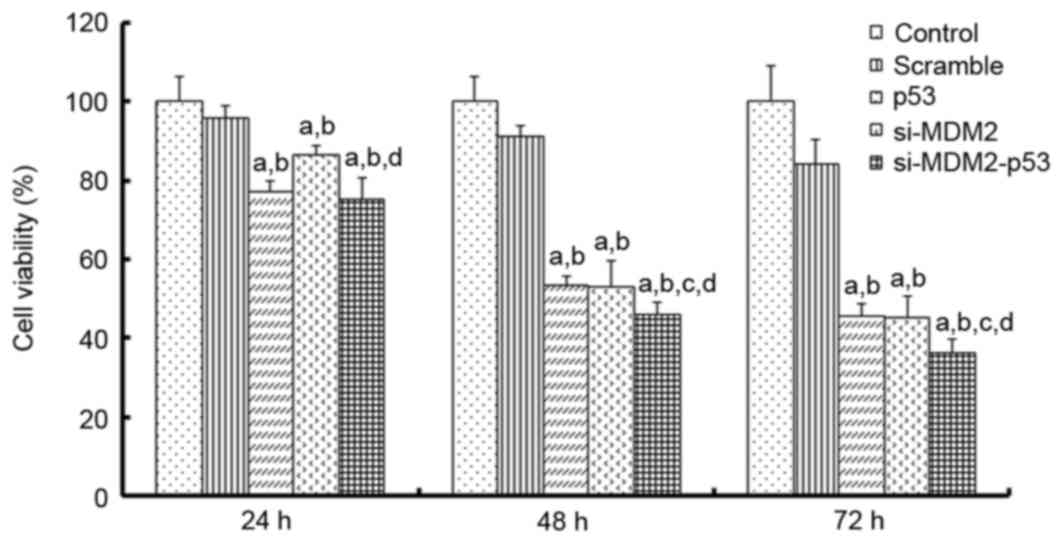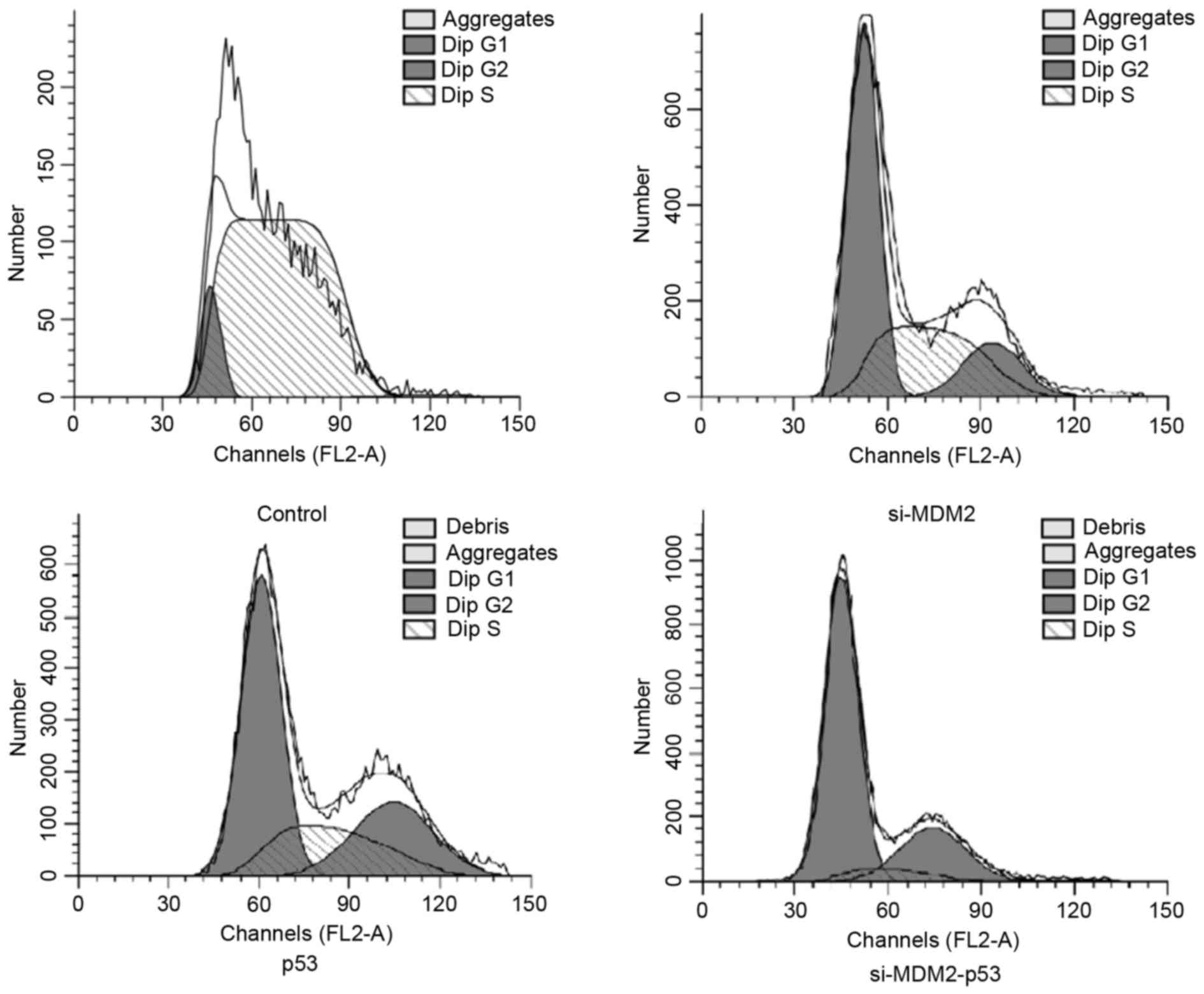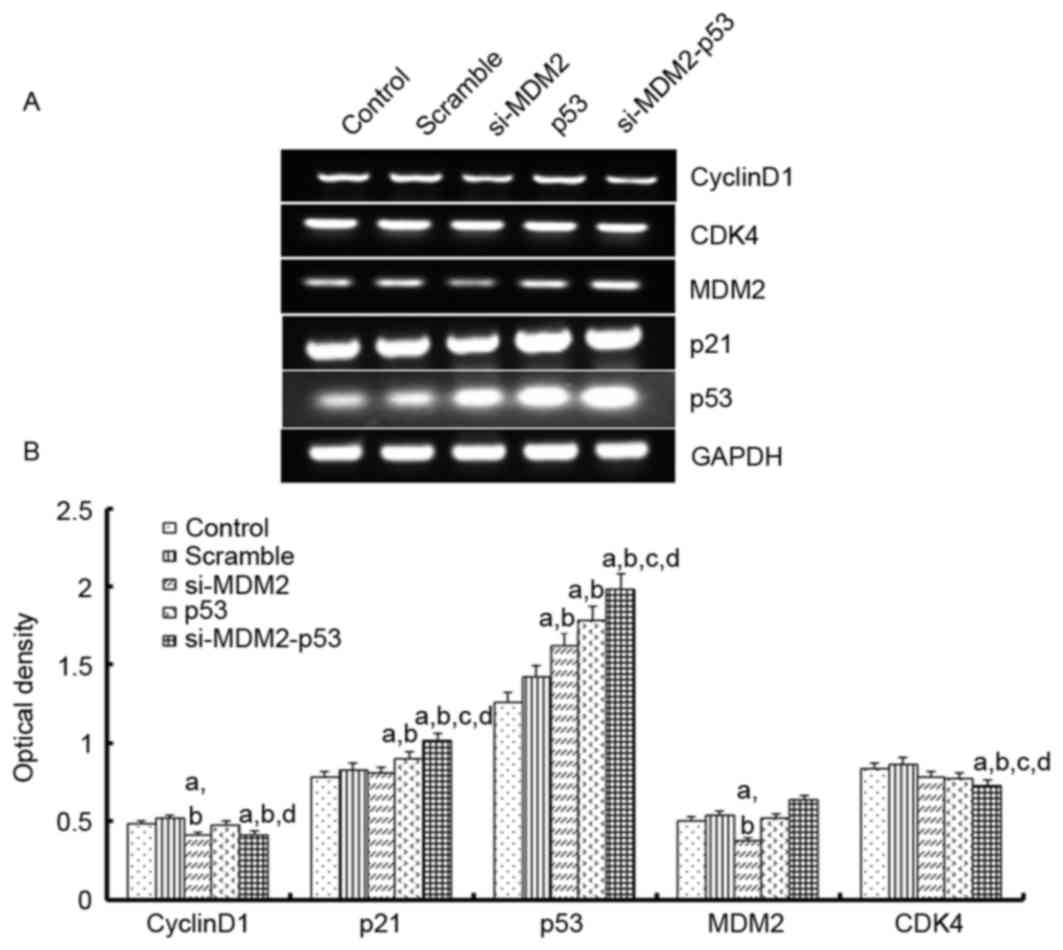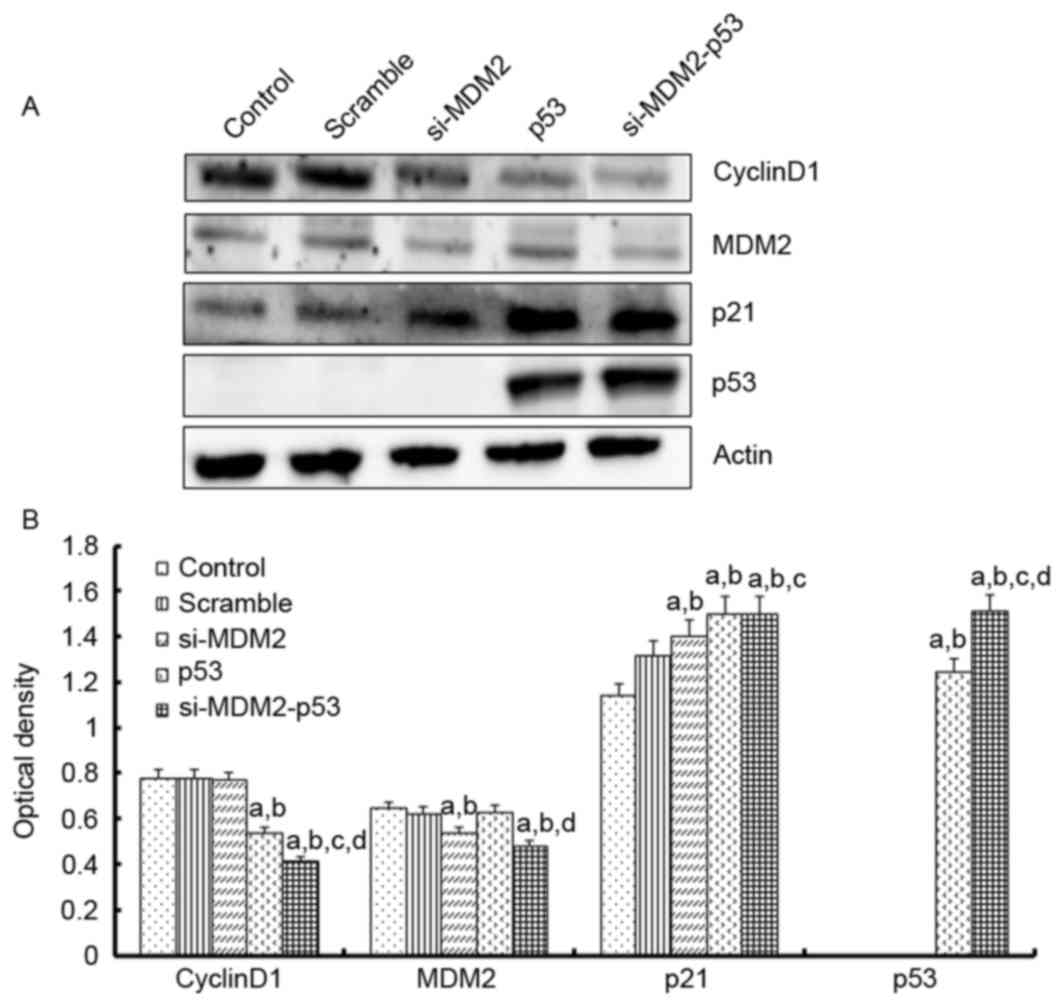Co‑expression of murine double minute 2 siRNA and wild‑type p53 induces G1 cell cycle arrest in H1299 cells
- Authors:
- Published online on: October 11, 2017 https://doi.org/10.3892/mmr.2017.7766
- Pages: 9137-9142
Abstract
Introduction
Lung cancer continues to be the leading cause of cancer-associated mortality in men and women worldwide (1). The average survival rate for a patient diagnosed with lung cancer is <5 years. Among the lung cancer subtypes, non-small cell lung cancer is the most common (2,3). In an attempt to overcome this problem, a growing number of therapeutic interventions have been developed to target lung cancer, including targeted thermal ablation, radiation therapy and biological therapy. In addition, small molecule gene therapy is considered an effective therapy for the treatment of lung cancer. In particular, using a combined-gene therapeutic approach has been reported to increase curative effects, and is often more effective than single gene therapy alone (4,5).
p53 is a well-known tumor suppressor gene that can activate genes responsible for regulating cell proliferation, apoptosis, cell cycle control, senescence, transcriptional regulation and DNA repair (6). In addition, p53 is able to regulate the tumor microenvironment by inhibiting the development of tumor vasculature. Approximately half of all human tumors contain a mutation in p53, which is associated with poor patient prognosis. Murine double minute 2 (MDM2) is an E3 ubiquitin ligase that can induce p53 inactivation by directly binding to it and promoting its ubiquitination (7). Ultimately, MDM2-mediated ubiquitination of p53 leads to its degradation by the 26S proteasome. Consequently, increased expression levels of MDM2 can inhibit p53 activity, thereby preventing its tumor suppressor function. Therefore, the present study knocked down MDM2 expression using small interfering (si)RNA to promote p53 transcriptional activity, and determined its effects on a lung cancer model (5,8).
One important characteristic of tumors is uncontrolled cell growth. Under normal conditions, cell proliferation is tightly regulated by the cell cycle. The eukaryotic cell cycle is regulated by the cyclin-dependent kinase (CDK) family (9), which contains protein kinases that comprise catalytic (CDK) and regulatory subunits (cyclin). Cyclin D-CDK4/6 and cyclin E-CDK2 are two types of G1 cyclin-CDK complexes that are required for entry into S phase of the cell cycle. Notably, increasing p53 levels have been reported to result in an upregulation in the protein expression levels of p21, which is an inhibitor of CDKs that can prevent the development of G1 CDK-cyclin complexes (10). In addition, p21 can prevent DNA synthesis and inhibit proliferating cell nuclear antigen; therefore, by increasing p53 levels, it is possible to induce p21 to cause G1 phase cell cycle arrest.
Small molecule gene therapy has received increasing amounts of attention; however, due to the complexity of tumors, a single gene therapy strategy is unlikely to be successful (11). Conversely, a combined-gene therapeutic approach has been reported to be more effective (4,7). Therefore, the present study induced co-expression of MDM2-specific siRNA and wild-type p53 (si-MDM2-p53) in H1299 lung cancer cells, and determined its effects on cell cycle progression and cancer cell viability.
Materials and methods
Cell culture and transfection
H1299 lung cancer cells (Sangon Biotech Co., Ltd., Shanghai, China) were cultured in RPMI-1640 medium (Hyclone; GE Healthcare Life Sciences, Logan, UT, USA) supplemented with 10% fetal bovine serum (Hyclone; GE Healthcare Life Sciences) and penicillin-streptomycin (1,000 µg/ml) at 37°C and in 5% CO2. When cells reached 70–90% confluence, they were transfected with scrambled siRNA [5′-GATCCGTATAAGTCAACTGTTGACttcaagagaGTCAACAGTTGACTTATACTTTTTTGGAAA-3′ (sense strand) and 5′-AGCTTTTCCAAAAAAGTATAAGTCAACTGTTGACtctcttgaaGTCAACAGTTGACTTATACG-3′ (antisense strand)] The lower case letters indicate non-homologus sequences. The plasmid of si-MDM2, the plasmid of p53 and the plasmid of si-MDM2-p53 (Jilin University, Jilin, China) were prepared as previously described (4,5). The plasmid si-MDM2 sequence: forward, 5′-CGTCGCGAGGGCTATGAACTAATGACCC-3′ and reverse, 5′-GCAGATCTTGCTTCGCGATGTACGGGCC-3′. The plamid p53 sequence: forward, 5′-CCATCTACAAGCAGTCACAG-3′ and reverse, 5′-CAAATCTACAAGCAGTCACAG-3′. PGCsiRNA-MDM2 (si-MDM2), pcDNA3.1-p53 (p53), pcDNA3.1-p53/U6 siRNA-MDM2 and p53 (si-MDM2-p53) (Jilin University, Jilin, China), these eukaryotic expression vectors were used to transfect the plasmids into cells using a transfection reagent (Thermo Fisher Scientific, Inc., Waltham, MA, USA). When the cell density reached to 85–90%, 6 µg of every plasmid was used to transfect into cells at 37°C. Following 48 h transfection, cells were then collected to analyze cell activity, protein and gene expression, and cell cycle progression.
MTT assay
A total of ~4.5×103 cells/well were incubated in a 96-well plate, and were cultured under normal growth conditions prior to transfection with si-MDM2, p53 or si-MDM2-p53 plasmids (Jilin University). Cell viability was measured by adding 20 µl MTT (Sangon Biotech Co., Ltd.) to each well 24, 48 and 72 h post-transfection. Following 4 h, 150 µl dimethyl sulfoxide (Sangon Biotech Co., Ltd.) was used to dissolve the crystals at room temperature, and the absorbance was measured at 490 nm using a microplate reader.
Flow cytometric analysis (FCM) to determine cell cycle progression
Cells were collected for FCM by washing twice with cold PBS (centrifuged at 1,000 × g for 5 min/wash, 4°C) and were digested with 0.25% EDTA-free trypsin. Following two further washes, 75% ethanol was added to the cells, and the cells were cultured at 4°C overnight. Subsequently, the cells were centrifuged at 4°C, 1,000 × g for 5 min, and the ethanol was discarded before washing the cells two more times. Finally, ~8×104 cells were resuspended in 200–500 µl PBS, stained with propidium iodide (100 µg/ml), and maintained in the dark for 30 min at room temperature. Cell cycle progression was analyzed using the Epics-XL-MCL flow cytometer (Beckman Coulter, Inc., Brea, CA, USA).
Western blot analysis
Cells were lysed with 100–150 µl radioimmunoprecipitation assay buffer supplemented with phenylmethylsulfonyl fluoride (Roche Diagnostics, Basel, Switzerland), and were sonicated 3–5 times (0°C, 5 sec every time) using ultrasound pyrolysis apparatus (Tomy Seiko Co., Ltd., Tokyo, Japan) to shear the cells. Subsequently, the cells were centrifuged for 20 min at 4°C, 12,000 × g, and the protein content in the supernatant was measured using Bradford reagent (Bio-Rad Laboratories, Inc., Hercules, CA, USA). The lysates (20 µg protein) were separated by 12% SDS-PAGE and were transferred onto polyvinylidene fluoride membranes at 0°C for 50 min, then blocking with 5 % nonfat milk at room temperature for 1 h (EMD Millipore, Bedford, MA, USA). The protein expression levels of p53, p21, cyclin D1 and MDM2 were detected by western blot analysis. Rabbit polyclonal anti-p21 (1:2,000; cat. no. 10355-1-AP) and rabbit polyclonal anti-p53 (1:1,000; cat. no. 10442-1-AP), were purchased from ProteinTech Group, Inc. (Chicago, IL, USA). Mouse polyclonal anti-cyclin D1 (1:200; cat. no. sc-450) and MDM2 (1:200; cat. no. sc-81218), were purchased from Santa Cruz Biotechnology, Inc. (Dallas, TX, USA); and rabbit polyclonal anti-pan-actin (1:1,000; cat. no. 8456) was purchased from Cell Signaling Technology, Inc. (Danvers, MA, USA). All the primary antibodies were incubated at room temperature for 4 h. Anti-rabbit (1:1,000; cat. no. SA00001-2) and anti-mouse (1:1,000; cat. no. SA00001-1) were purchased from ProteinTech Group, Inc. (Chicago, IL, USA), they were incubated at room temperature for 1 h. Proteins were detected using an enhanced chemiluminescence kit (cat. no. 120702-74; Advansta, Inc., Menio Park, CA, USA). The images were captured using a Syngene Bio Imaging System (Synoptics, Cambridge, UK).
Reverse transcription semi-quantitative polymerase chain reaction [RT-(sq)PCR]
H1299 cells were harvested from a 6-well plate. The cells were washed twice, following this 500 µl TRIzol® (Invitrogen; Thermo Fisher Scientific, Inc.) was added to each well and incubated at room temperature for 5 min. Subsequently, trichloromethane was added, and following centrifugation at 4°C, 2,000 × g for 5 min, minisopropanol was added to the aqueous phase. Finally, 75% ethanol was used to wash RNA prior to resuspending it in RNase-free water. Subsequently, 5 µg total RNA (purified following DNase I treatment) from each sample was converted to cDNA using an RT kit (Thermo Fisher Scientific, Inc., Waltham, MA, USA), which was performed according to the manufacturer's protocol. The primer sequences and reaction conditions are presented in Tables I and II. The PCR products were separated on a 2% agarose gel, and visualized by ethidium bromide staining then images were captured using the image processing system (Tanon, 1600R; Tanon Science and Technology Co., Ltd., Shanghai, China). Statistical analysis was then carried out.
Statistical analysis
Data are presented as the mean ± standard deviation. SPSS 19.0 (IBM Corp., Armonk, NY, USA) was used to statistically analyze the data using single factor analysis of variance and least significant difference to test the multiple comparisons. P<0.05 was considered to indicate a statistically significant difference.
Results
Effects of si-MDM2, p53 or si-MDM2-p53 plasmids on the proliferation of H1299 cells
To determine whether simultaneously inhibiting MDM2 and overexpressing wild-type p53 was able to inhibit the proliferation of lung cancer cells, H1299 cells were transfected with si-MDM2, p53 or si-MDM2-p53 plasmids and cell proliferation was analyzed at 24, 48 and 72 h using an MTT assay. The results indicated that si-MDM2, p53 and si-MDM2-p53 plasmids inhibited cell proliferation (Fig. 1). Notably, after 48 h the si-MDM2-p53 plasmid was able to inhibit cell proliferation by ~50%, which was more than p53 or si-MDM2 alone (P<0.05). Taken together, these results indicated that the si-MDM2-p53 plasmid may significantly inhibit the proliferation of H1299 cells.
Effects of si-MDM2, p53 or si-MDM2-53 plasmids on cell cycle arrest
In order to determine whether manipulating the MDM2/p53 pathway could affect the cell cycle, FCM was used to analyze cell cycle progression in H1299 cells. The results demonstrated that the percentage of cells in G1 phase was increased when cells were transfected with si-MDM2, p53 or si-MDM2-53 plasmids (Fig. 2). Furthermore, FCM indicated that co-expression of si-MDM2 and the p53 overexpression plasmid resulted in a significant increase in the number of cells in G1 phase cell cycle arrest, compared with the cell transfected with si-MDM2 or p53 plasmids alone (P<0.05). The percentages of cells in G1 phase from each group are presented in Table III.
Effects of si-MDM2, p53 or si-MDM2-53 plasmids on the expression of cell cycle-associated genes and proteins in H1299 cells
To investigate the mechanism underlying the effects of the si-MDM2, p53 and si-MDM2-53 plasmids on G1 phase cell cycle arrest and cell proliferation, the mRNA expression levels of p21, cyclin D1, CDK4 and MDM2 were determined by RT-(sq)PCR, and the protein expression levels of p53, p21, cyclin D1 and MDM2 were determined by western blot analysis, respectively (Figs. 3 and 4). The results indicated that the protein and mRNA expression levels of p53 and p21 were significantly increased when the H1299 cells were transfected with si-MDM2, p53 or si-MDM2-53 plasmids, compared with the control or scramble groups (P<0.05). In addition, there was a significant decrease in the protein and mRNA expression levels of cyclin D1 and MDM2, and a significant decrease in the mRNA expression levels of cyclin D1, MDM2 and CDK4 (P<0.05).
Discussion
Effective therapeutic strategies for the treatment of lung cancer remain a major obstacle, particularly because patients often present at terminal stages. Furthermore, the low diagnostic accuracy of clinical staging delays the optimum time for effective treatment (12,13). Small molecule gene therapies for lung cancer are considered a potentially effective therapeutic approach; however, care must be taken to identify the appropriate combination of gene therapies for the effective treatment of lung cancer.
The results of the present study demonstrated that p53 serves an important role in regulating the oncogenic behavior of H1299 cells. Under normal conditions, p53 is suppressed by MDM2, which results in the maintenance of low p53 nuclear levels (6,14–16). Notably, MDM2 inhibits p53-mediated apoptosis, DNA repair and cell cycle arrest; however, in response to stress, including oxidative or DNA replication stress, hypoxia or oncogenic activation, the negative loop between p53 and MDM2 is broken, and p53 expression is stabilized by post-translational modifications (17,18). Specifically, MDM2 releases p53, thereby allowing p53 to translocate to the nucleus, bind its target genes and activate downstream genes that combat the source of stress. In the present study, it was indicated that si-MDM2-p53 was able to significantly inhibit the proliferation of H1299 cells, and that si-MDM2 and p53 co-expression could increase the expression of p53 (19,20).
Regulation of the cell cycle is a complex procedure that is regulated by complex mechanisms, and is controlled by critical regulatory genes, including CDKs and their regulatory inhibitors (21,22). It has previously been reported that p21 is associated with cell cycle regulation. For example, p21 is an inhibitor of CDKs that inhibits the expression of G1 CDK-cyclin complexes. Notably, p21 is a downstream target gene of p53 (23). Upon being subjected to stress, p53 protein levels are increased, which results in a corresponding increase in p21 protein levels. In addition, CDK2, CDK4 and CDK6 are downregulated by p21 (24,25). In the present study, FCM was used to detect alterations in the cell cycle progression of H1299 cells in response to si-MDMD2, p53 overexpression or both. A significant increase in G1 phase cell cycle arrest was detected following transfection with the si-MDM2-53 plasmid, compared with si-MDM2 or p53 alone.
In conclusion, the present study used a si-MDM2 and p53 co-expression plasmid to disrupt the negative feedback loop between MDM2 and p53, and to increase the expression levels of p53 (26,27). The results indicated that in H1299 lung cancer cells transfected with the si-MDM2-53 plasmid, p53 and p21 expression levels were increased, whereas CDK4 and cyclin D1 were downregulated, at the protein and mRNA levels. These results suggested that downregulation of MDM2 and upregulation of p53 may induce inhibition of H1299 cell proliferation and cell cycle arrest. Taken together, the use of a si-MDM2-p53 co-expression plasmid may offer a novel gene therapy that targets lung cancer.
Acknowledgements
The present study was supported by the Research Fund for the National Natural Science Foundation of China (grant no. 81572927), the National Natural Science Foundation of China (grant no. 81501982) and the Scientific and Technological Research Planning Project of Education in Jilin Province (grant no. 20150414025GH).
References
|
Siegel RL, Miller KD and Jemal A: Cancer statistics, 2015. CA Cancer J Clin. 65:5–29. 2015. View Article : Google Scholar : PubMed/NCBI | |
|
Zhang Y, Zhang G, Li X, Li B and Zhang X: The effect of ribosomal protein S15a in lung adenocarcinoma. PeerJ. 4:e17922016. View Article : Google Scholar : PubMed/NCBI | |
|
Riley T, Sontag E, Chen P and Levine A: Transcriptional control of human p53-regulated genes. Nat Rev Mol Cell Biol. 9:402–412. 2008. View Article : Google Scholar : PubMed/NCBI | |
|
Gu J, Wang B, Liu Y, Zhong L, Tang Y, Guo H, Jiang T, Wang L, Li Y and Cai L: Murine double minute 2 siRNA and wild-type p53 gene therapy interact positively with zinc on prostate tumours in vitro and in vivo. Eur J Cancer. 50:1184–1194. 2014. View Article : Google Scholar : PubMed/NCBI | |
|
Ji K, Wang B, Shao YT, Zhang L, Liu YN, Shao C, Li XJ, Li X, Hu JD, Zhao XJ, et al: Synergistic suppression of prostatic cancer cells by coexpression of both murine double minute 2 small interfering RNA and wild-type p53 gene in vitro and in vivo. J Pharmacol Exp Ther. 338:173–183. 2011. View Article : Google Scholar : PubMed/NCBI | |
|
Ayroldi E, Petrillo MG, Bastianelli A, Marchetti MC, Ronchetti S, Nocentini G, Ricciotti L, Cannarile L and Riccardi C: L-GILZ binds p53 and MDM2 and suppresses tumor growth through p53 activation in human cancer cells. Cell Death Differ. 22:118–130. 2015. View Article : Google Scholar : PubMed/NCBI | |
|
Gu J, Tang Y, Liu Y, Guo H, Wang Y, Cai L, Li Y and Wang B: Murine double minute 2 siRNA and wild-type p53 gene therapy enhances sensitivity of the SKOV3/DDP ovarian cancer cell line to cisplatin chemotherapy in vitro and in vivo. Cancer Lett. 343:200–209. 2014. View Article : Google Scholar : PubMed/NCBI | |
|
Guo H, Li Y, Gu J, Wang Y, Liu L, Zhang P and Liu Y: Effect of vascular endothelial growth factor siRNA and wild-type p53 co-expressing plasmid in MDA-MB-231 cells. Mol Med Rep. 13:461–468. 2016. View Article : Google Scholar : PubMed/NCBI | |
|
Elmetwali T, Salman A and Palmer DH: NORE1A induction by membrane-bound CD40L (mCD40L) contributes to CD40L-induced cell death and G1 growth arrest in p21-mediated mechanism. Cell Death Dis. 7:e21462016. View Article : Google Scholar : PubMed/NCBI | |
|
Zheng QH, Ma LW, Zhu WG, Zhang ZY and Tong TJ: p21Waf1/Cip1 plays a critical role in modulating senescence through changes of DNA methylation. J Cell Biochem. 98:1230–1248. 2006. View Article : Google Scholar : PubMed/NCBI | |
|
Hensing T, Chawla A, Batra R and Salgia R: A personalized treatment for lung cancer: molecular pathways, targeted therapies, and genomic characterization. Adv Exp Med Biol. 799:85–117. 2014. View Article : Google Scholar : PubMed/NCBI | |
|
Wang HQ, Jin JJ and Wang J: Arctigenin enhances chemosensitivity to cisplatin in human nonsmall lung cancer H460 cells through downregulation of survivin expression. J Biochem Mol Toxicol. 28:39–45. 2014. View Article : Google Scholar : PubMed/NCBI | |
|
Li H, Wang X, Chen T and Qu J: p38 inhibitor SB203580 sensitizes the resveratrol-induced apoptosis in human lung adenocarcinoma (A549) cells. J Biochem Mol Toxicol. 26:251–257. 2012. View Article : Google Scholar : PubMed/NCBI | |
|
Vassilev LT, Vu BT, Graves B, Carvajal D, Podlaski F, Filipovic Z, Kong N, Kammlott U, Lukacs C, Klein C, et al: In vivo activation of the p53 pathway by small-molecule antagonists of MDM2. Science. 303:844–848. 2004. View Article : Google Scholar : PubMed/NCBI | |
|
Shinohara T and Uesugi M: In-vivo activation of the p53 pathway by small-molecule antagonists of MDM2. Tanpakushitsu Kakusan Koso. 52(13 Suppl): S1816–S1817. 2007.(In Japanese). | |
|
Marine JC and Lozano G: Mdm2-mediated ubiquitylation: P53 and beyond. Cell Death Differ. 17:93–102. 2010. View Article : Google Scholar : PubMed/NCBI | |
|
Liu J, Zhang C, Wang XL, Ly P, Belyi V, Xu-Monette ZY, Young KH, Hu W and Feng Z: E3 ubiquitin ligase TRIM32 negatively regulates tumor suppressor p53 to promote tumorigenesis. Cell Death Differ. 21:1792–1804. 2014. View Article : Google Scholar : PubMed/NCBI | |
|
Harris SL and Levine AJ: The p53 pathway: Positive and negative feedback loops. Oncogene. 24:2899–2908. 2005. View Article : Google Scholar : PubMed/NCBI | |
|
Pajalunga D, Mazzola A, Salzano AM, Biferi MG, De Luca G and Crescenzi M: Critical requirement for cell cycle inhibitors in sustaining nonproliferative states. J Cell Biol. 176:807–818. 2007. View Article : Google Scholar : PubMed/NCBI | |
|
Odkhuu E, Mendjargal A, Koide N, Naiki Y, Komatsu T and Yokochi T: Lipopolysaccharide downregulates the expression of p53 through activation of MDM2 and enhances activation of nuclear factor-kappa B. Immunobiology. 220:136–141. 2015. View Article : Google Scholar : PubMed/NCBI | |
|
Valesky EM, Hrgovic I, Doll M, Wang XF, Pinter A, Kleemann J, Kaufmann R, Kippenberger S and Meissner M: Dimethylfumarate effectively inhibits lymphangiogenesis via p21 induction and G1 cell cycle arrest. Exp Dermatol. 25:200–205. 2016. View Article : Google Scholar : PubMed/NCBI | |
|
Kim SY, Kim JE, Lee KW and Lee HJ: Lactococcus lactis ssp. lactis inhibits the proliferation of SNU-1 human stomach cancer cells through induction of G0/G1 cell cycle arrest and apoptosis via p53 and p21 expression. Ann N Y Acad Sci. 1171:270–275. 2009. View Article : Google Scholar : PubMed/NCBI | |
|
Chu K, Gao G, Yang X, Ren S, Li Y, Wu H, Huang Y and Zhou C: miR-512-5p induces apoptosis and inhibits glycolysis by targeting p21 in non-small cell lung cancer cells. Int J Oncol. 48:577–586. 2016. View Article : Google Scholar : PubMed/NCBI | |
|
Baharuddin P, Satar N, Fakiruddin KS, Zakaria N, Lim MN, Yusoff NM, Zakaria Z and Yahaya BH: Curcumin improves the efficacy of cisplatin by targeting cancer stem-like cells through p21 and cyclin D1-mediated tumour cell inhibition in non-small cell lung cancer cell lines. Oncol Rep. 35:13–25. 2016. View Article : Google Scholar : PubMed/NCBI | |
|
Harper JW, Adami GR, Wei N, Keyomarsi K and Elledge SJ: The p21 Cdk-interacting protein Cip1 is a potent inhibitor of G1 cyclin-dependent kinases. Cell. 75:805–816. 1993. View Article : Google Scholar : PubMed/NCBI | |
|
Devany E, Zhang X, Park JY, Tian B and Kleiman FE: Positive and negative feedback loops in the p53 and mRNA 3′ processing pathways. Proc Natl Acad Sci USA. 110:pp. 3351–3356. 2013; View Article : Google Scholar : PubMed/NCBI | |
|
Tang Y, Cui Y, Li Z, Jiao Z, Zhang Y, He Y, Chen G, Zhou Q, Wang W, Zhou X, et al: Radiation-induced miR-208a increases the proliferation and radioresistance by targeting p21 in human lung cancer cells. J Exp Clin Cancer Res. 35:72016. View Article : Google Scholar : PubMed/NCBI |













